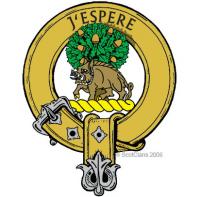
Clan Swinton
The surname Swinton is believed to be territorial in origin; deriving from the Barony of Swinton, which was granted to Eadulf Ros by Malcolm III around 1060. The Swintons are Anglo-Saxon in origin, descending from the royal House of Bamburgh from the ancient Kingdom of Northumberland. They are widely accepted as being one of the oldest landed families in Britain. The gift of the Barony of Swinton by the king was a thanks for the military support Eadulf had given him. The family are said to have cleared the barony of wild boar, something that the family’s clan crest and the chief’s coat of arms alludes to.
Malcolm III’s son, Edgar, granted the village of Swinewood, in Berwickshire, to Liulf of Bamburgh in 1098. Liulf’s family were the Earls of Northumberland, and it is from them that the Clan Dunbar also originated. It is claimed that Liulf’s grandson, Ernulf, was the first instance of a Scottish knight. Ernulf’s son was Cospatric, who was allegedly the father of Hugh de Swinton, an ancestor of the Arbuthnot clan.
Around 1140, Edulph de Swinton was given from David I one of the first ever recorded charters in Scotland confirming his property at Swinton. It was during the reign of William the Lion that the Swintons had the Barony of Swinton officially confirmed to them by charter. Sir Alan de Swinton, 6th of Swinton, obtained this from the Prior of Coldingham. There is a tomb in Swinton Church that is believed to belong to Sir Alan.
William de Swinton, the priest at Swinton Church, and his brother Henry both had their names attached to the Ragman Rolls pledging allegiance to England’s Edward I in 1296. Henry was actually one of the 13 claimants for the Scottish throne put forward by Edward. However, during the Wars of Independence, the Swintons supported Robert the Bruce.
During the times of both Robert II and Robert III, Sir John Swinton, Henry de Swinton’s great-grandson, was a distinguished statesman and soldier. At the 1388 Battle of Otterburn John was a commander under the Earl of Douglas, helping to ensure a Scottish victory over the English. Sir John was appointed on two occasions by Robert III to go to England and negotiate a treaty with the English court. He was granted safe conduct from the English monarch both times: the first from Richard II in 1392, and the second in 1400 from Henry IV. Sir John Swinton was killed leading his clan at the Battle of Homildon Hill in 1402 where the English crushed the Scottish army. It is said that Swinton died a heroic death. He left one son, also John, from his third marriage to Princess Margaret, daughter of Robert Stewart, Duke of Albany. His son later became Sir John Swinton of Swinton, and thought to have been the 15th Lord of the name.
The 15th Lord fought on the continent during the Hundred Years’ War (1337-1453) alongside the French. Sir John led Clan Swinton in at the Battle of Baugé in 1421, where the Franco-Scottish forces won a decisive victory. It is said that during this battle it was Swinton who slew the Duke of Clarence, Henry V of England’s brother, however, a number of people have been credited with this kill. The incident appears in Sir Walter Scott’s poem ‘The Lay of the Last Minstrel’. Three years later at the Battle of Verneuil, Sir John was killed in an English victory that proved to have been significant.
When the James Hepburn, Earl of Bothwell married Mary, Queen of Scots in 1567, a number of Scottish barons, including Sir John Swinton, signed a bond denouncing the couple in an act to protect the infant James VI, who would become king only two months later.
The 22nd chief of the Swintons was Sir Alexander Swinton. In 1640 he became sheriff of Berwickshire. Sir Alexander died twelve years later, in 1652, leaving behind him eleven children: six sons and five daughters. His second son, also Alexander, was appointed in 1688 to the Scottish Supreme Court, taking the title Lord Mersington.
During the Civil War the Swintons were Royalists, supporting the cause of Charles I. During the 1651 Battle of Worcester, Sir Alexander’s eldest son, John, was a colonel in the regiment of Berwickshire and was taken prisoner by the parliamentarians, whilst his brother, Robert, was killed when he attempted to capture Oliver Cromwell’s standard. John was, however, later appointed by Cromwell to the Council of the State in 1655, allowing him to aid in the governing of Scotland. In 1661, after the monarchy had been restored, John Swinton was tried for treason for his association with Cromwell. He managed to avoid a death sentence, and instead he was sent to prison for six years and all of his lands were forfeited. John died in 1679, his son Alexander succeeding him as the 24th Laird of Swinton. Alexander died without having children, and so the title passed to his brother, Sir John Swinton. Sir John had a successful career in Holland as a merchant and returned to Scotland in 1688 in the wake of the Glorious Revolution, which saw William of Orange come to the British throne with his wife Mary. Sir John Swinton regained the estates that his father had lost and sat in the Scottish Parliament, and later the British one at Westminster.
In 1782, the 27th Laird, John Swinton of that Ilk, took the title ‘Lord Swinton’ after he became a member of the Supreme Court.
Former Lord Lyon Captain George Swinton was Secretary to the Order of the Thistle from 1926 to 1929. He descended from the Swintons of Kimmerghame, and was the great-grandfather of actress Tilda Swinton. His son, Major-General Sir John Swinton, resided at Kimmerghame. The current chief of the Clan Swinton is Rolfe Swinton (36th of that Ilk). He became chief after the passing of his father Sir John Swinton. The Swinton family still reside at Kimmerghame.





